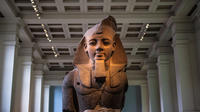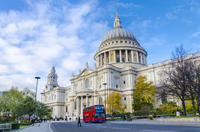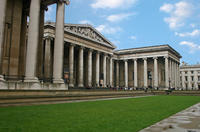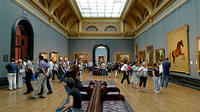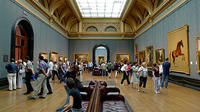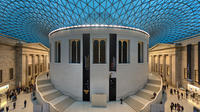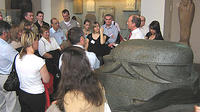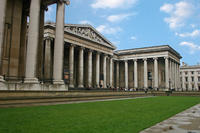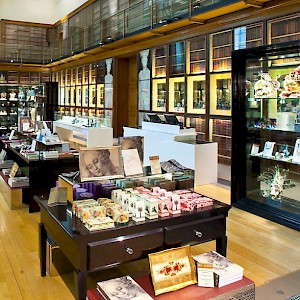The British Museum ★★★
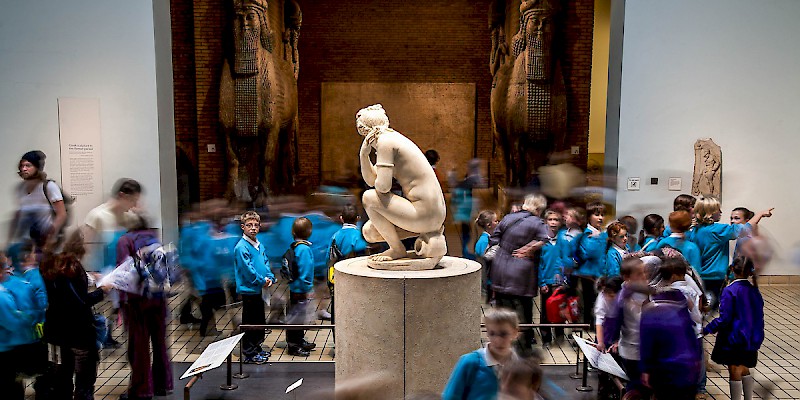
One of the greatest museums on the planet, a repository of astounding artifacts from throughout human history all around the globe, from the Rosetta Stone to the Parthenon Marbles to an Easter Island moai and much, much, much more
The Brits have quite possibly the world’s greatest archaeological collection. You can spend several days exploring this intriguing museum, although you can also do the highlights in two to three hours.
My advice: Spend a couple of half-days here. After all, it’s free.
Highlights of the British Museum
The British Museum has treasures that span history as well as the globe, from the Rosetta Stone—the key that cracked the code of Egyptian hieroglyphics—to the towering Assyrian lamassus, winged bull/men that guarded the gates to Assyrian palaces in 880 B.C., a moai from Easter Island, and the 11,000-year-old Ain Sakhri Lovers, the world's oldest depiction of two people making love, found in cave near Bethlehem.
You can also see the famous Parthenon Marbles, the grandest of the carved reliefs that once decorated Athens’s Parthenon. (These sculptures are still more famously, though politically incorrectly, known as the "Elgin Marbles" after Lord Elgin, the man who helped remove them from Athens to England. Calling them "The Parthenon Marbles" is a lame, politically correct attempt to distance the museum from the fact that Lord Elgin essentially stole them "for safekeeping." They can call them whatever they like, It does not change the fact that, despite Greece's decades of pleading, and even their construction of a state-of-the-art museum expressly to house these marble masterpieces—Athens' not having an adequate home for them was long the excuse Britain used to keep refusing to repatriate the artifacts to Greece—the British Museum stubbornly refuses to return the antiquities to their rightful heirs and owners. Shameful, really, but still lovely to look at.)
Kids seem fascinated by room after room of royal Egyptian mummies, to say nothing of the 2,000-year-old Lindow Man, who was ritually strangled and drowned in a peat bog that preserved his shriveled body.
Tips
I've been the British Museum roughly two dozen times, and there are still galleries in which I've never even set foot. Several days would not be enough to explore every nook and historical cranny of this fascinating museum.
This is one of the world's great museums. It takes at least 2–3 hours to see all the highlights.
My advice: Spend a couple of half-days here (followed by a pub grub lunch at the old Museum Tavern across the street from the main entrance). After all, it's free.
Any time I get rained out of other sightseeing in London, I just head to the British Museum instead.
Guided "Highlights Tours" (90 min) are offered Fri-Sun at 11:30am and 2pm for £12 per person, but the British Museum also runs several free tours throughout the week:
- “Eye Opener” tours - Themed tours of parts of the collections (30–40 min).
- Lunchtime gallery talks - Lectures by a guest speaker or curator, Tues-Fri at 1:15pm (45 min).
- Friday evening "Spotlight" tours - Hilights by culture; Every Friday evening (20 min).
The British Museum has one of the world's best museum gift stores (several outlets are scattered around the building; the largest ring the cylindrical library in the middle of the central Great Court atrium). From replica jewelry and objects to toys and games to shelf after shelf of amazing books, it's a great place to pick up souvenirs and presents for the folks back home. » more
Daily, from 11am to 4pm, volunteers staff desks in a half-dozen populer galleries to let visitors handle objects from the museum's collections and answer questions. This is free, and great for the kids.
Here are the rooms where you can find Hands On desks:
- Room 1 - Enlightenment Gallery
- Room 2 - Collecting the World
- Room 24 - Living and Dying Gallery
- Room 33 - China, India, South Asia and Southeast Asia Gallery
- Room 49 - Roman Britain Gallery
- Room 68 - Money Gallery



















